Different Ways Of Holding A Pencil
Do You Know How to Hold a Pencil Correctly?
The correct way to hold a pencil is by using the tripod grip where the thumb, index, and middle finger hold the pencil.
Schools teach the tripod grip to young children as once mastered. It gives greater control of the pencil.
The tripod grip may be a good way to grasp and control a pencil, but it takes time to learn it properly and many young children find it uncomfortable or painful to write with.
Studies show that it may not enable children to write faster and neater and may not even be the best way to hold a pencil.
In this guide, we will cover all the different ways to hold a pencil with their benefits and drawbacks.
So let's get started

Table of Contents
- 1 How to Hold a Pencil with the Tripod Grip
- 1.1. How to Hold a Pencil With The Static Tripod Grip
- 1.2. How to Use The Dynamic Tripod Grip
- 1.3. How to Hold a Pencil With The Adaptive Tripod Grip
- 1.4. How to Hold a Pencil With The Lateral Tripod Grip
- 2. How to Hold a Pencil with the Quadrupod Grip
- 2.1. How to Hold a Pencil With the Lateral Quadrupod Grip
- 3. How to Hold a Pencil With Your Left Hand
- 3.1. Hold the Pencil Higher
- 3.2. Angle the Paper The Opposite Way to A Right-Handed Writer
- 3.3. Specialist Left Handed Pencils
- 4. How Should a Toddler Hold A Pencil?
- 5. How Should a Kindergartener Hold a pencil?
- 6. The Best Way To Hold a Pencil
- 6.1. The Three Types of Immature Pencil Grasp
- 7. How to Use a Pencil Grip
- 7.1. Thumb and Index Finger Guided Pencil Grip
- 7.2. Triangular Shaped Grip Pencil Grip
- 7.3. Molded Pencil Grip
- 7.4. Gel and Foam Grips
- 8. How to Hold a Pencil to Write Neat
- 9. How to Hold a Pencil For Drawing
- 9.1. Tripod Grip
- 9.2. Underhand Grip
- 9.3. Overhand Grip
- 9.4. Palm Side Grip
- 9.5. Brush Grip
- 9.6. How to Control a Pencil to Draw Different Line lengths
- 10. How to Hold a Pencil Without Pain
- 11. How to Hold a Pencil with Long Nails
Many school teachers consider the tripod grip as the proper way to hold a pencil.
They teach young children how to hold a pencil using the tripod grip when first learning to write.
1.1. How to Hold a Pencil With The Static Tripod Grip
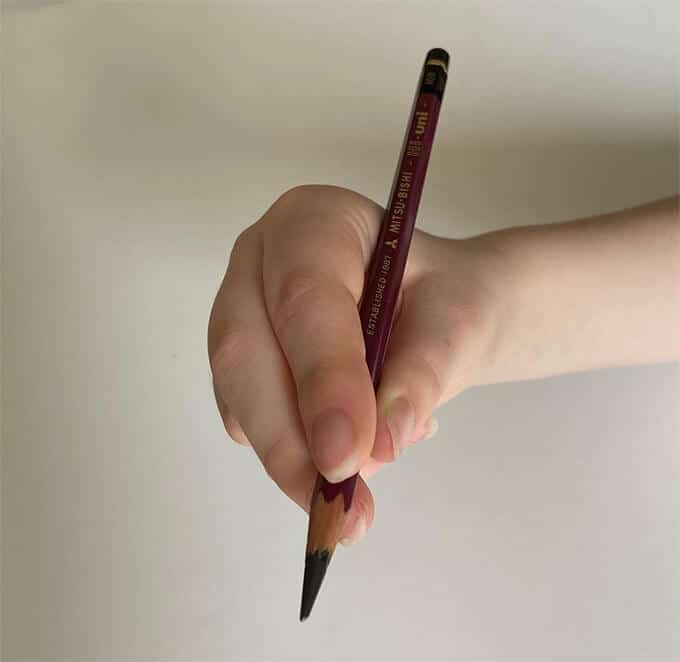
To hold a pencil using the static tripod grip, gently grip the pencil with the thumb and index finger and then pinch it with the middle finger.
Turn the paper to a slight angle this will help you see your pencil point while writing.
Rest your hand on the table
Make sure the angle of the pencil is back towards you, nestling between your thumb and index finger.
Use your other hand to rest on the paper and keep it still.
1.2. How to Use The Dynamic Tripod Grip
The dynamic tripod grip is just a fancy way of describing how you move your fingers/ hand to control the pencil and form the letters and words on the paper.
Ideally, you should keep the ring and little finger still and use the thumb index, and middle finger to control the movement of the pencil.
This uses fewer muscles for writing. If you are using more muscles, i.e. the other fingers and your wrist, it can lead to pain in the wrist or the tendons can get tight.
The major benefit of using the tripod grip to hold a pencil is that it gives a lot of control over the pencil. With plenty of practice, this should lead to neat handwriting.
The downside of this method is that it takes time for your muscles to develop, and in the beginning, many children find it very uncomfortable or even painful to write with.
1.3. How to Hold a Pencil With The Adaptive Tripod Grip

The adaptive tripod grip uses the same fingers as the Tripod Grip however, the pencil rests between the index and middle finger as opposed to the dynamic tripod grip, where it rests between the thumb and the index finger.
Gently grip the pencil with the thumb and index finger and then pinch it with the middle finger.
Turn the paper to a slight angle this will help you see your pencil point while writing.
Rest your hand on the table
Make sure the angle of the pencil is back towards you, nestling between your index and middle finger.
Use your other hand to rest on the paper and keep it still.
1.4. How to Hold a Pencil With The Lateral Tripod Grip
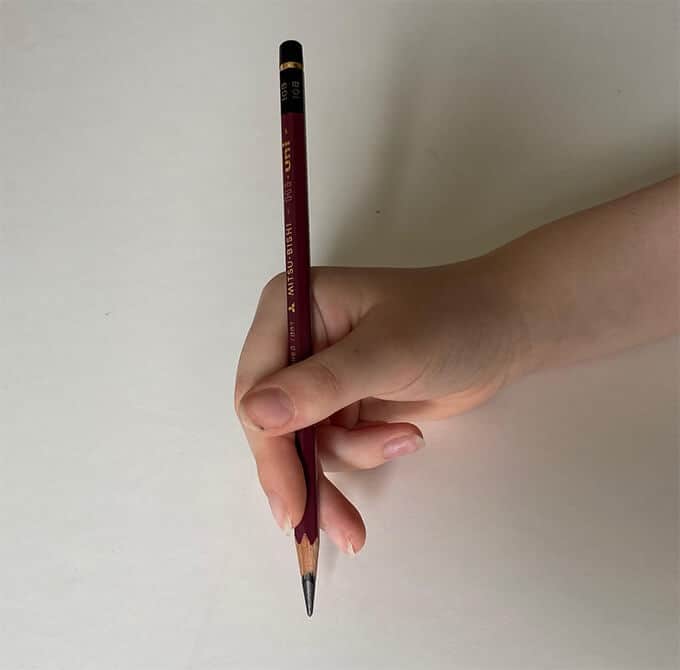
The Lateral Tripod Grip uses the same fingers as the tripod grip however this time, the thumb does not grip the barrel of the pencil, but we wrap it over it to touch the index finger.
Gently grip the pencil with the index finger and middle finger, then position your thumb so that it crosses the barrel and touches your index finger.
Turn the paper to a slight angle this will help you see your pencil point while writing.
Rest your hand on the table
Make sure the angle of the pencil is back towards you, nestling between your thumb and index finger.
Use your other hand to rest on the paper and keep it still.
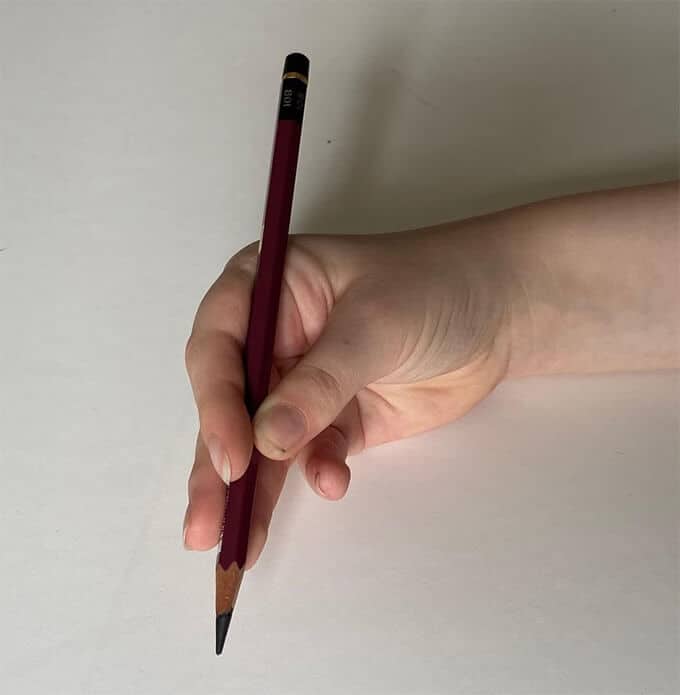
The quadrupod grip is the second most popular of the traditional recognized conventional ways of holding a pencil. Instead of using three fingers (tri), Four fingers (quad) are used to grip the pencil.
How to Hold a Pencil With the Quadrupod Grip:
To hold a pencil with the quadrupod grip, gently grip the pencil with the thumb, index, and middle finger and then rest it on your ring finger.
Turn the paper to a slight angle this will help you see your pencil point while writing.
Rest your hand on the table
Make sure the angle of the pencil is back towards you, nestling between your thumb and index finger.
Use your other hand to rest on the paper and keep it still.
The major benefit of using the Quadrupod grip to hold a pencil is that it does not put a lot of stress on your fingers.
Some teachers believe the Quadrupod Grip restricts the movements of your fingers and hinders the flow of writing.
Although there is now plenty of evidence proving this to be incorrect and we go into more detail later on in the section The Best Way to Hold a Pencil
2.1. How to Hold a Pencil With the Lateral Quadrupod Grip
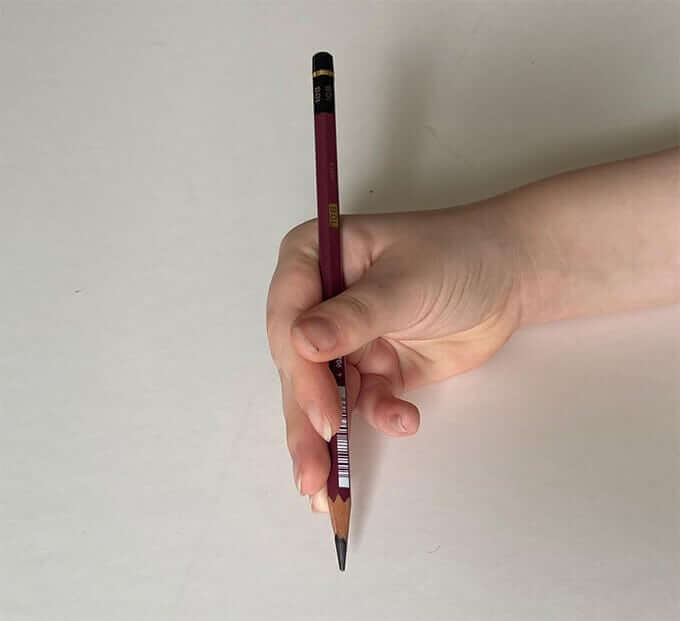
The lateral quadrupod grip uses the same four fingers as the quadrupod grip, but this time the thumb crosses the pencil and sits on top of the index finger.
To hold a pencil with the lateral quadrupod grip gently grip the pencil with the index and middle finger and then rest it on your ring finger, then cross the pencil with your thumb and sit it on top of your index finger.
Turn the paper to a slight angle this will help you see your pencil point while writing.
Rest your hand on the table
Make sure the angle of the pencil is back towards you, nestling between your thumb and index finger.
Use your other hand to rest on the paper and keep it still.
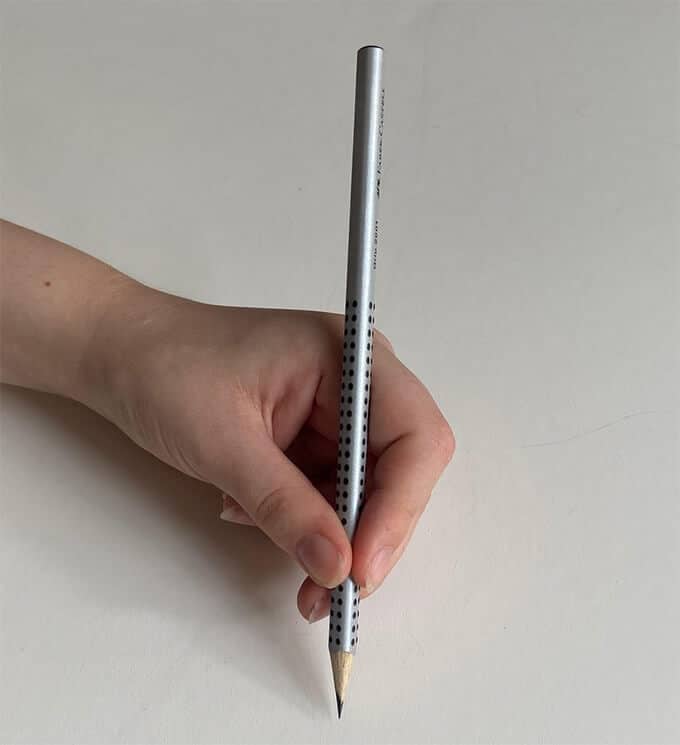
To hold a pencil with your left hand, then you can use whichever grip you find most comfortable. However, you need to make a couple of slight changes to your grip from that of a right-handed writer.
3.1. Hold the Pencil Higher
The first thing that left-handed writers need to do is hold the pencil further slightly higher up the barrel so that their fingers are further away from the tip of the pencil.
If you are teaching a left-handed child to write, then the Faber-Castell Grip 2001 pencils are excellent for this.
They have a triangular-shaped barrel with a series of black grips on the barrel.
The triangular shape helps the child with finger position when learning to master the dynamic tripod grip.
With the black dots providing a great visual aid, you can encourage the child to place their fingers on the barrel with four dots visible below them.
This gives a lefty a better view of the tip so that they can write neater.
3.2. Angle the Paper The Opposite Way to A Right-Handed Writer
One tip to improve your writing is to turn the paper or notebook to an angle. Left-handed writers need to angle it the opposite way to a right-hander.
To angle, the paper, hold the top with your left hand and then push the bottom of the paper to the left. This gives the best possible view of the tip of the pencil as you write.
3.3. Specialist Left Handed Pencils
There are a couple of specially designed pencils to aid left-handed writers to place their fingers in the correct position. Which is more comfortable and gives greater control when writing.
Made by the German pencil manufacturer Stabilo, they designed the following pencils for younger left-handed writers.
Stabilo EasyGraph Ergonomic Left Handed Pencil

Scientists have specially designed the Stabilo EasyGraph ergonomic left-handed pencils for children learning how to write.
The pencils have a triangular-shaped barrel with a series of non-slip cutouts molded into the barrel to aid the correct finger placement.
This ensures that the hand is in a relaxed position and it is very comfortable to write with, even for extended periods of time.
Stabilo EasyErgo 1.4 mm Ergonomic Left-handed Mechanical Pencil

The Stabilo EasyErgo 1.4mm ergonomic left-handed mechanical pencil is for children aged 5 years and older.
It has a specially designed grip whose shape is perfect for children that are left-handed writers.
The pencil is very comfortable to hold, and we can refill it with 1.4 break-resistant mm lead.
Unlike other mechanical pencils, it only has two parts and is perfectly safe for young children to use, although Stabilo recommends we do not leave children unsupervised when writing with these pencils.
Stabilo EasyErgo 3.15 mm Ergonomic Left-handed Mechanical Pencil

The Stabilo EasyErgo 13.15mm ergonomic left-handed mechanical pencil is for children aged 5 years and older.
It has a specially designed grip whose shape is perfect for children that are left-handed writers.
It has a thicker lead than the 1.4 mm pencil, children may find the thicker lead easier to start with. Once they are used to it, then they can start using the thinner 1.4 mm pencils.
There are also special left-handed pens check out The Best Pens For Left-Handed Writers.
We should encourage toddlers to hold pencils in whatever way feels natural and comfortable for them. There is no right or wrong way for them to hold the pencil and their grip develops in a natural progression.
When a toddler first gets hold of a pencil, they will usually form their hand into a fist around the pencil and use their shoulders and the whole of their arm to move it across the paper.
As they get older, they will usually alter their grip so that they hold a pencil in the palm of their hand and close their fingers around it.
We know this type of grip as a Palmer Grasp and they still use their shoulders and entire arm to move the pencil across the paper.
When a child starts kindergarten, they have not developed their muscles enough to write with the classic dynamic tripod pencil grip. This is where three fingers are used to hold the pencil and control its movement.
They will probably hold their pencil in a Palmer Grasp discussed in the previous section about how toddlers hold a pencil.
Kindergartner teachers will encourage children to hold their pencil in a static tripod grip (3 fingers) or a static Quadrupod grip (4 fingers).
The pencil is now being held in the correct position and the child is no longer using their shoulders and entire arm to move the pencil but controlling its movement with their wrist.
As the child's muscles develop, they control the pencil's movements with either three or four fingers, depending on their grip (dynamic tripod grip/quadrupod grip).
Although teachers encourage children to write with the "proper pencil grip," there is a lot of research that shows comfort is more important than the type of grip used to hold the pencil.
If you need a pencil for your kindergartner Check out our guide on The 10 Best Pencils for Kindergarteners.
Which we will go into in more detail in the next section.
What is the best way to hold a pencil?
The best way to hold a pencil is in a way that is comfortable for you to write in an efficient legible style. The way you hold your pencil will usually fall into one of the following four mature grasp styles.
- Dynamic Tripod
- Lateral Tripod
- Dynamic Quadrupod
- Lateral Quadrupod
If you are using one of these four mature handwriting styles, none of them are better than the other three. There is plenty of research that shows that the way you hold or grip your pencil does not have as big an impact as many teachers believe.
The American Journal of Occupational Therapy carried out a study of how 120 children held their pencil and concluded that:
"pencil grasp patterns did not influence handwriting speed or legibility. "
Where the problems can arise is if you have not developed a mature Grasp and are still using an immature grasp where the wrist controls the movement of the pencil.
6.1. The Three Types of Immature Pencil Grasp
- Static Tripod Grasp
- Interdigital Grasp
- Lateral Thumb-Wrapped Grasp
If you or your child has one of these types of immature grasps, then it would be advisable to seek advice from a professional occupational therapist.
This may cause problems not only with handwriting legibility but also with joints and muscles.
A pencil grip is a tool that can aid children who are learning how to write. It can either be to aid correct finger position or to make the pencil easier to grip with the hand using less pressure.
Pencil Grips For Finger Position
There are three main types of pencil grip to aid children in the correct placement of their fingers for a dynamic tripod grip.
7.1. Thumb and Index Finger Guided Pencil Grip
In this type of grip, the thumb and index finger slide into a hollow guide, and the middle finger is then used to rest the pencil against and complete the grip.
7.2. Triangular Shaped Grip Pencil Grip
The triangular-shaped grip, as its name suggests, is a 3 sided grip that slides over the pencil. The thumb, index finger, and middle finger grip on the sides in a dynamic tripod grip.
7.3. Molded Pencil Grip
The molded pencil grips are very similar to the triangular-shaped grips. As opposed to having three defined straight edges, they have three softer molded areas for the fingers to grip.
7.4. Gel and Foam Pencil Grips
We use gel and foam grips where the child is gripping to pencil too tightly or finding it difficult to hold a pencil with a thinner barrel.
They are a wide soft grip that slides over the pencil's wooden barrel and relieves pressure, giving maximum comfort when writing.
To write neatly with a pencil, many teachers believe that mastering the dynamic tripod grip is the best way, as it gives you a lot of control over the pencil when writing.
However, in our guide How to Write Fast and Neat in 6 Simple Steps, this may not be correct, as comfort is more important than how you hold your pencil.
How you hold your pencil when drawing differs according to what the effect is that you are trying to achieve and what the surface is that you are working on.
There are five main types of grips to hold a pencil when drawing and artists use a combination of all five, as each grip is better suited for different effects.
9.1. Tripod Grip
When drawing, we use the tripod grip for detailed work and precise short lines. The fingers control the pencil it is a tight grip that limits the movement of the pencil.
9.2. Underhand Grip

With the underhand grip, we hold the pencil further up the barrel with the thumb and index finger; the palm is facing up and the other fingers rest against the barrel.
We control the pencil by moving the shoulder, which allows a free-flowing continuous movement.
Using this technique enables the pencil to draw from the side of the graphite, giving longer, softer, and wider lines.
This type of grip is ideal for the outline strokes or to control the tip for finer, more precise, long lines.
The slight drawback with this grip is that it is not very suitable for use when drawing on horizontal surfaces.
9.3. Overhand Grip

For the overhand grip, we hold the pencil the same way as the underhand grip further up the barrel with the thumb and index finger.
The other fingers rest along the barrel however, this time the palm is facing downwards. Again, the shoulder is used to control the pencil's movement.
We can use either the tip of the pencil for long precise lines or the edge of the graphite for softer, broader lines.
The advantage of this type of grip for drawing is that it can easily draw on horizontal, vertical, or surfaces tilted at an angle.
9.4. Palm Side Grip

You can easily alternate between the overhand and underhand grip by rotating your hand through 180 degrees we hold the pencil the same way.
If you only rotate your hand 90 degrees, then the palm is on its side and gives a slightly different feel when drawing in this manner.
9.5. Brush Grip
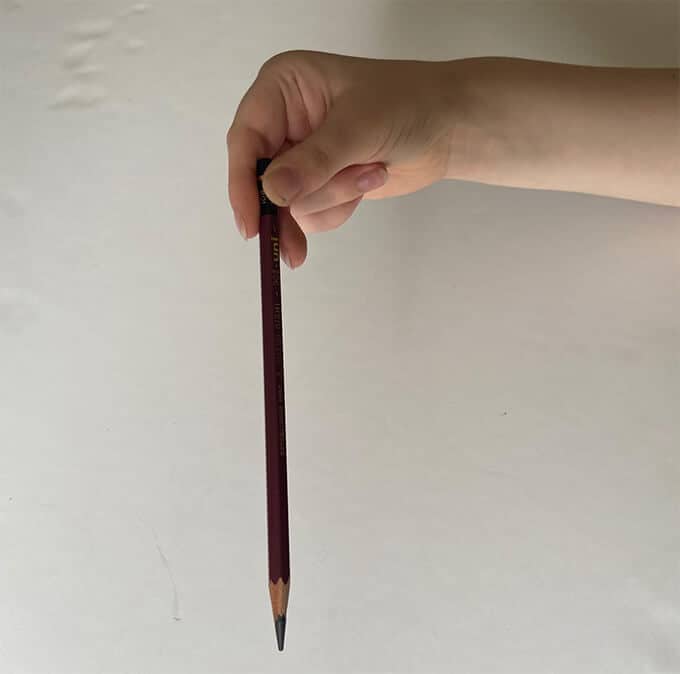
To hold a pencil in a brush grip it is very similar to how we hold a paintbrush. We hold the pencil at the rear of the pencil with the thumb, index and middle finger as you would with a tripod grip but a lot looser.
The brush grip is a very natural way of holding a pencil there is a lot more freedom of movement and it is used to draw loose strokes.
9.6. How to Control a Pencil to Draw Different Line lengths
- Short Lines – The movement of the finger controls the pencil.
- Slightly Longer Lines – The movement of the finger and wrist control the pencil.
- Longer Lines – The movement of the wrist controls the pencil.
- Very Long Lines – The movement of the shoulder controls the pencil.
How hard should you grip a pencil?
Someone should only grip a pencil hard enough to control its movement. If too much pressure is used to grip a pencil, then it will become uncomfortable to hold.
This can lead to the fingers become sore and problems with the wrists and muscles.
If you grip a pencil too hard, then use a foam or gel grip to relieve the pressure and make it more comfortable to write with.
If you are experiencing pain when you write, then seek professional advice from an occupational therapist or hand therapist. They will look at your grip and recommend any changes that you need to make.
The American Society of Hand Therapists website has a directory where you can search for a hand therapist in your area.
The best way to hold a pencil with long nails is to hold it further up its barrel with the use of a lateral tripod grip. This gives more room for your nails while still being able to have proper control over the pencil.
To use a lateral tripod grip, we hold the pencil with the index finger and middle finger and the thumb crossing the barrel.
Now that you know the different ways to hold a pencil and can find the grip that is best for you check out our How to Choose a Pencil – The Ultimate Guide.
References
Typical Pencil Grasp in a Nursery/Reception Class
Different Ways Of Holding A Pencil
Source: https://blog.penvibe.com/how-to-hold-a-pencil/
Posted by: hobgoodpaptur.blogspot.com

0 Response to "Different Ways Of Holding A Pencil"
Post a Comment